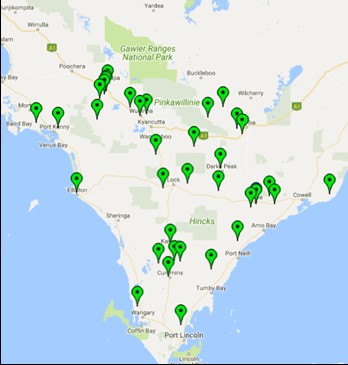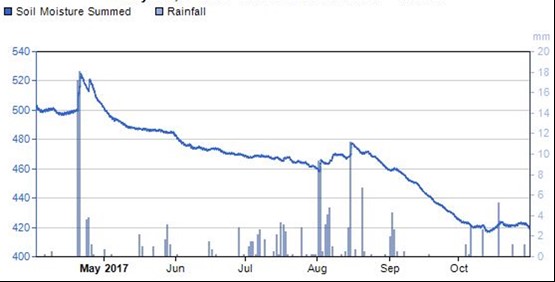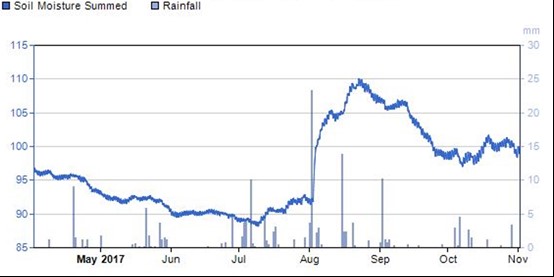Soil moisture probe network - using soil water information to make better decisions on the Eyre Peninsula
Author: Andrew Ware (SARDI, Port Lincoln) and Naomi Scholz, Brenton Spriggs and Sue Budarick (SARDI, Minnipa Agricultural Centre) | Date: 01 Aug 2018
Take home messages
- A network of soil moisture probes and weather stations has been established across the Eyre Peninsula.
- The ‘live’ data can be viewed by visiting the https://eparf.com.au/ website and then clicking on the yellow Soil Moisture Probe Network icon in the top right-hand side and logging on using the user name: EPARF and password: EPARF.
Background
Water is the principal limiting factor in rain-fed cropping systems in South Australia. The research that French and Schultz (1984) conducted linked growing season rainfall to grain production, providing growers and advisers with a target yield potential. However, this had deficiencies in that it didn’t account for out of season rainfall and treated the water holding capacity of all soils equally.
A better understanding of the how plant available water content varies with changes to soil type and how valuable out of season rainfall can be to cropping systems in different environments improves the French Schultz model by allowing growers to define better define target yields, but also make informed in-season decisions based on the information they receive.
Being able to monitor soil moisture in real time by using technology such as soil moisture probes connected to the mobile phone network allows growers and advisers access to improved soil water information, allowing them to make more informed decisions.
In 2016 SAGIT and EPARF provided funding to create and monitor a network of new and existing soil moisture probes across Eyre Peninsula, with the aim assisting growers and advisers to interpret the data produced by the moisture probes and link the soil water information to yield potential so that improved crop decisions can be made.
Method
A network of 32 soil moisture probes across the Eyre Peninsula has been created by linking new and existing (EPNRM and LEADA funded) soil moisture probes found across the Eyre Peninsula and providing access to the data via the EPARF website (Figure 1).

Figure 1. Locations of the soil moisture probes on Eyre Peninsula.
In addition, weather stations capable of logging temperature, humidity and wind speed have also been installed at ten soil moisture probe sites funded through contributions by EPARF and AgFarm. This data can also be accessed by logging into the soil moisture probe network via the EPARF website.
Soil testing for soil chemistry and soil moisture was conducted at 29 of the sites in late March 2017 and again in March 2018. In 2017, 15 of the sites were planted to wheat, seven to pasture, four to pulse crops, three to barley and two to canola. Soil moisture testing and hand harvest samples were conducted at 26 sites in early November, at crop maturity. The sites that weren’t tested at this time were not mature and rainfall shortly after meant that soil testing for moisture at these sites was futile.
Seventeen sites were characterised for drained upper limit and bulk density in 2017 and early 2018. Yield Prophet® was also run at eight sites in 2017 (Lock, Cleve, Elliston, Kimba, Ungarra, Warramboo, Pinkawillinie and Karkoo) and a further eight sites in 2018 (Kimba, Yabmanna – Cleve, Cowell, Cootra, Lock, Warramboo, Pygery and Yeelanna. Small trials were established at five sites in 2017 (Pinkawillinie, Warramboo, Ungarra, Karkoo and Rudall), where additional nitrogen (N) was applied in replicated plots adjacent to soil moisture probes.
Results and discussion
Figure 2 demonstrates a soil moisture probe site that was planted to wheat in early May 2017, following a break to the season in late April. The figure shows how soil moisture started from a high point through being able to retain moisture from summer rainfall events, and then gradually declines as soil moisture is used throughout the growing season.

Figure 2. Summed soil moisture chart showing total soil moisture in the soil profile (line) and rainfall (columns) during the 2017 growing season (April-October) at a site that was planted to wheat in 2017.
Figure 3 demonstrates a soil moisture probe site that was pasture in 2017. The figure shows how soil moisture started from a low point after summer weeds were allowed to survive and use most of the out of season rainfall, and then how soil moisture was accumulated through the growing season, ending up with more soil moisture at the end of the season compared to the start. This may indicate that the poor growth that pastures were able to achieve in 2017 may have a role in conserving moisture for the following wheat crops or also have the potential to be better used to grow more fodder to feed livestock in the pasture phase.

Figure 3. Summed soil moisture chart showing total soil moisture in the soil profile (line) and rainfall (columns) during the 2017 growing season (April-October) at a site that was a regenerated pasture in 2017.
Conclusion
The 2017 growing season was challenging for many growers on the Eyre Peninsula, but having improved knowledge of soil water information will allow a better understanding of yield potentials during the growing season and help tailor inputs such as in-season N applications and assist in grain marketing decisions.
Interpretation of the information that the soil moisture probes are providing will need at least another season to be fully realised. The extra season will help determine the ‘bucket size’ or soil water holding capacity at each site. Then a quick view of the soil moisture probe output through the EPARF website at any time during the season will allow growers to determine how full the bucket is.
Useful resources
References
French RJ, Schultz JE (1984) Water use efficiency of wheat in a Mediterranean type environment. I. The relation between yield, water use and climate. Australian Journal of Agricultural Research 35, 743-764.
Acknowledgements
The authors would like to acknowledge SAGIT for funding project EP216. EPARF, LEADA and EPNRM and Agfarm for also providing funding that has contributed to developing the soil moisture probe network. The various grower co-operators for allowing us to access to the soil moisture probes on their properties. Shane Oster, Alpha Group, for maintaining the probe network and developing the website platform so that the soil moisture probe information can be viewed.
Contact details
Andrew Ware
Lincoln Marine Science Centre
1 Hindmarsh Street, Port Lincoln, SA 5606
0427 884 272
andrew.ware@sa.gov.au
Was this page helpful?
YOUR FEEDBACK
